MCS Theory of Cognition, Four Colors of Life and Classical Perspectives in Philosophy

Content:
Preamble
Abstract
1 Introduction
2 Real
3 Imaginary
4 Value
5 Collective
6 Bridges between real and imaginary worlds
7 Memory and regularities
8 Singular case of time. Correspondence between real and imaginary.
9 Boundaries between real and imaginary
10 Conclusion
References
Preamble
This section relates
- on the one hand the MCS theory of cognition [P1] and the proposed four “colors” of life
- with on the other hand the classical views of philosophy.
Most of the content of this section is available in a recent publication [P2].
[P1] Jean-Daniel Dessimoz, « Cognition and Cognitics – Definitions and Metrics for Cognitive Sciences, in Humans, and for Thinking Machines, 2nd edition, augmented, with considerations of life, through the prism “real – imaginary – values – collective”, and some bubbles of wisdom for our time », Roboptics Editions llc, Cheseaux-Noreaz, Switzerland, 345 pp, March 2020.
[P2] Dessimoz, Jean-Daniel, «Colors of MCS Cognition Theory and Classical Perspectives in Philosophy », Complements, Roboptics Editions llc, Cheseaux-Noreaz, Switzerland, 8 Aug. 2020, 10 pp. ; click here to download the document in pdf format (ca. 206 Kb).
Abstract
The four-color model of the MCS theory of cognition (real, imaginary, values and collective) offers an interesting prism to reinterpret the propositions of classical philosophers and to put into perspective the updates and complements that this MCS theory proposes in relation to traditional achievements: a new, axiomatic and quantitative approach to knowledge, intelligence and cognition in general, the latter considered both intrinsically (including a kind of epistemology taking into account our computerized world) and in relation to real life. The general view is completed by more particular aspects where these colours still intervene: bridges between the real world and the imaginary world; memory and regularities; the singular case of time; limits between the real and the imaginary.
1 Introduction
Philosophy has progressed with the contributions of countless thinkers. Many have made significant advances, which have influenced many generations of human beings, and they still allow our contemporaries to take possible new steps (cf. e.g. [1]). The philosophers cited in the following lines as examples are often emblematic of multiple communities, each representing a whole current of thought.
The objective of this document is to put into perspective the updates and complements that the MCS[F1] theory of cognition proposes (notably [2]), in relation to traditional achievements.
Let’s look at this, using the structure of the four “colors” of MCS cognition: real, imaginary, values and collective. This is indeed a model, with the advantages (clarity, simplicity, pragmatism) and limitations (incompleteness, arbitrariness and diversity of aspects considered) inherent in any modeling. A first visit via these four concepts is then completed by more particular aspects where these colors still intervene, before finally concluding: bridges between the real world and the imaginary world; memory and regularities; the singular case of time; and limits between the real and the imaginary.
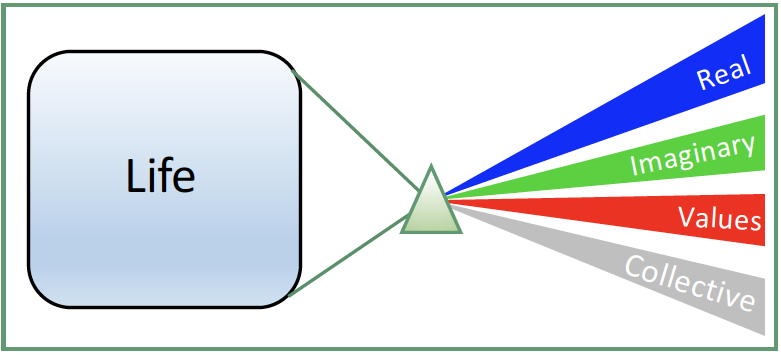
2 Real
The important thing, the unavoidable, is the real thing.
Parmenides best defined the real: “What is, is; what is not, is not” (Sachot, for example, provides a good synthesis, with multiple references, of what the – real – traces left by Parmenides tell us today in this regard [3] ).
Reality imposes itself, and limits itself exclusively to itself.
The cherry tree in my garden is (in bloom in spring, leafless in winter).
Planet Earth is (at the moment round, and turning on itself? warming?).
The nature of Spinoza [4] is.
René Descartes (of whom there are now real traces that he had thought in his time [5]) “is” (currently both in the form of dust and in particular as a reference often cited in philosophical context).
In 1969, our philosophy teacher, the excellent Augustin Fontannaz, at the College of Sion, who was also a priest and Director of the institution, presented this thesis of Parmenides to us, young students. Personally, I had then felt a very pleasant dizziness at the idea that “what is not” (for more clarity, less ellipse, I would add here, in pleonasm, the attribute that imposes itself on me, “real”, what is not real therefore), “is not”; decidedly, one should not drop the prey for a shadow; a bird “in the hand” is worth several ” in the bush “; and above all, one should not (no longer?) risk the exhaustion of the mind in wanting to deal with quantities of hypotheses, virtually possible in infinite numbers.

3 Imaginary
When reality provides the necessary infrastructure, it is possible for an imaginary world to develop. For Heidegger, for example, everyone exists with a whole inner world of an imaginary nature (cf. Umwelt, Mitwelt, Selbswelt, in his vocabulary [6 and 1]).
Outside the real, this imaginary world, surprisingly, and despite its immateriality, also often proves to be very useful; the imaginary is probably a determining component, which has allowed and continues to allow the development of the living, in a very concrete way, in the real.
The first interest of this imaginary world is to be able to represent the real, with the fundamental difference that none of the constraints of the real impose themselves on it, neither necessarily nor spontaneously. If the agent who imagines, wishes it, similar constraints can nevertheless in principle also be defined there, to a certain extent, notably by exploiting the laws that scientists are constantly discovering and refining in the field of physics.
Consider a mirror, for example. There is no one behind the mirror. The image reflected by the mirror, however, seems to actually come from a non-material scene behind the mirror. The perceived scene seems very similar, at least in luminous terms, to reality, which in this case is located elsewhere. Although non-material, this virtual scene is often useful in concrete terms. This non-real world (in particular, in this case, virtually located behind the mirror) is imaginary.
The most fascinating feature of the imaginary is therefore to offer a world free of all physical laws – except of course, as a prerequisite, the necessary support of an operational infrastructure well established in the real world: energy, memory, cognitive engine.
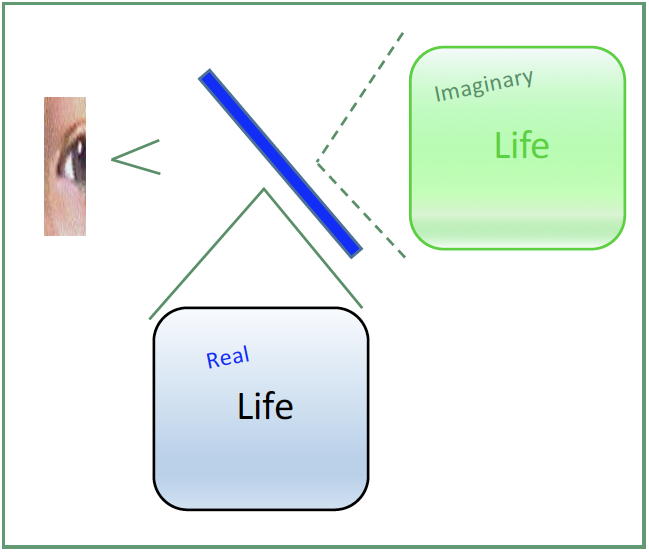
Imaginary is an essential component of cognition [2], and as such, it allows the following advantages in particular:
• To know the real world, to explore, to perceive, and to model.
• Defining alternative worlds and possible futures, visions, thus triggering the possibility of the anti-causality principle.
• Looking at the imaginary in a broader way, extending it beyond the individual towards a collective horizon, more complex structures appear, such as groups (agents bound together by mutual communication and a common culture), capable of even higher degrees of action and of dynamics for change.
• In the technical field, the cognitive approach ensures the success of countless control and adaptation processes.
• More generally, automation, by targeting cognitive processes, triggers a technical deployment of cognition (including, in popular parlance, artificial intelligence) on a very large scale, to the benefit of humanity and ecology.
Nevertheless, some caution is required. As Parmenides expressed it well, to proclaim more than the modest observation that the real “is” is to fall into the imaginary, into the doxa according to his jargon; it is to fall into this non-being, this unreality of which he warns us to be wary, as if it were a mirage. Of course, in the imaginary world, in a conceptual way then, “everything is possible”; in this world, “ifs” and ands” may be pots and pans and consequently there is no longer work for tinkers’ hands; non-being can be, as being can no longer be (note that this latter assertion is Hegel’s first antithesis).
The first capacity that the imaginary allows is the comparison, and therefore, as a corollary, the estimation of probability. It is on this basis that permanence and change can be conceived, thus forming the bases of the notion of time (cf. below, §8 Singular case of time): comparing an object in the instant with its traces, the agent can determine its possible constancy, and deduce consequently the probability of maintenance, permanence, if the probability is high, or on the contrary change, if the probability is low.
The being sketched by Parmenides, or by Spinoza in particular, is a being that both perdures and evolves, changing shape, like matter in Lavoisier [8 and 9] or energy in physics [10], or even like the cherry tree in my garden. This can be reconciled with the notion of time in a broad sense (“c-time” in reference to [2]). Two good analogies here would be the reel of a film, or a landscape including some water flowing under a bridge.
But other philosophers have implicitly taken time in the strict, more specific sense of permanence, as a particular image on the film reel, or as the bridge in our analogy. For example:
– Plato and his Ideas [11].
– Zeno and the impossibility of perceiving motion, which he tries to demonstrate (cf. [11, or 12].
– Hegel, starting his reflections with the concept of a universal and static “being”; or continuing his reflections by exploiting the freedom of the imaginary to solicit nothingness, to make nonbeing “be” in it, in an equally universal and static way.
Still other thinkers have also taken time in the strict sense, but not in the form of permanence, but in its opposite form, of change. In our analogy, it’s like the film running at 24 frames per second, or like water flowing under the bridge. This view, mainly centered on change, is often proposed; here are some examples:
– the Milesian school [13] imagines a fluid as the primordial element of being.
– Heraclitus [14 and 1] is emblematic of this view where change is the first property of the being; this one is thus fire, and interconnections between opposites.
– More than in the previous lines, Hegel is above all emblematic of the idea of change, with his dialectical system where the being dances in three steps, being, no longer being, and finally “becoming”. Hegel’s system thus evolves from its most global and abstract level to its most detailed and apparently concrete elements and manifestations[F2].
4 Value
The real is critical to the viability of the agent, of the living organism. The agent must therefore, as a priority, detect opportunities and threats in the real that concerns him or her, and distinguish adequately between these opportunities and threats; thus, distinguishing good from evil. Applicable to both the real and imaginary worlds, this type of judgment must guide the agent’s actions to optimize his or her chances of survival.
In ordinary life, value is most often understood as a degree of correspondence on a given dimensional axis. In a less common and yet more fundamental way, value is also the very property that this axis characterizes in quantitative terms (axiological property). Thus, in the fundamental case just mentioned, the property of the axis is survival, and the degree of correspondence is measured there towards the positive for good and towards the negative for evil.
This first case is typical in that the notion of value appears in a context involving the future, purpose, and intentionality (survival). Value is then synonymous with a goal, a criterion of priority choice relative to a future state.
In practice, for the human or any cognitive agent, this general approach is implemented in a progressively more concrete way, at multiple levels, which could be described as strategic, then tactical or technical.
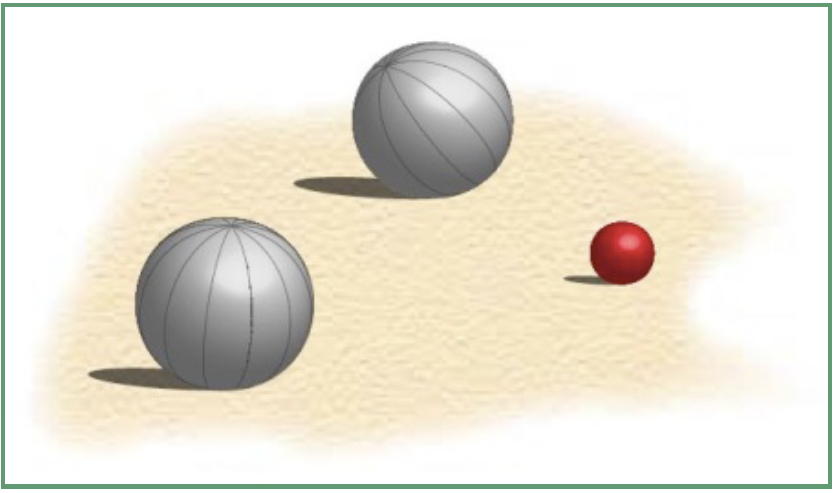
Aristotle perceives in nature the principle of motion, constantly aiming at a progress, an adaptation towards a later, more favorable situation; without determining its modalities (this strong idea is almost universal; even if it appears in a sometimes surprising way, like the direction of History in Marx [15 and 1], the vital impetus (élan vital) in Bergson [16], or the invitation to the Übermensch in Nietzsche ([17, or in a more synthetic way, cf. 1]).
For centuries, a great uneasiness persisted because philosophers typically interpreted the future and final causes in the real world, thus subject to physical laws, and in this sense out of reach at the present moment.
Now, this view of time according to Aristotle, Augustine of Hippo [18], or Jean-Paul Sartre [19] for example, this convention of time intuitively well understood by everyone in our cultures, this convention also considered to be an iron law for the positivists (e.g. Auguste Comte [20]) or in Science (the hard sciences), this concept of time, therefore, is a product of the imaginary. The laws of physics do not apply to it, so, even for the thinking agent screwed to the present, the future can freely be visited, at infinite speed, both in the direction of a future as distant as desired, and in the opposite direction, returning to the present, or even continuing into the past, and arbitrarily going back to the moment of the Big Bang and even further. Bergson noticed this distinction of temporality between the real world and the imaginary world at best, himself firmly anchored in the real, and thus in his “duration”, and thus observing that causality in the sense of physical laws could very well accommodate factors coming from that imaginary future, factors also imagined in the current moment. Let us add as a corollary, that this is therefore done with inevitable errors, and in an infinitely incomplete manner in relation to the actual future, which the real, at its inviolable rhythm, will end up revealing when the moment comes. Soeren Kierkegaard [21] is also famous for the similar importance (and in my opinion also obviously well justified, since the cradle of the real) that he grants at the moment, already well before Bergson.
Karl Jaspers [22] has also reframed Freud’s claims to a scientific approach by distinguishing on the one hand the causes as commonly admitted in science, and thus necessarily coming from the past (in his jargon, an explanatory mode of reasoning), and on the other hand the motives, linked to intentionality, finality, the future, and thus necessarily imagined (understanding mode of reasoning).
In an even more radical way, Bertrand Russel [23] notes that both the past and the future are not (or in other words, are imaginary), and consequently even the causal links, so fundamental in Science, are based on faith!
Let us recall nevertheless that despite the undeniable limits mentioned, the advantages that the imaginary can bring remain indispensable and fascinating, including through the contributions of science, and they are even more obvious if we consider their necessity to support the estimation of values and therefore already for simple survival in biology.
5 Collective
To make life easier, the individual agent can rely to a large extent on himself, but this is not enough for all purposes; and this impossibility is even more evident when the agent wishes to change the world ambitiously; additional forces must be mobilized collectively to achieve this kind of goals. Humans know how to organize themselves in this way; as Aristotle formulated it very early in our history, humans are political animals.
The sensations of pleasure and pain as well as the stimuli perceived through the senses inform the consciousness of the subject, who observes himself and his more or less close environment, and who gradually recognizes himself in this environment as an individual agent. Robin Dunbar is particularly famous for his estimate of the number of people with whom a human can personally cooperate over time, i.e. about one hundred and fifty people [24]. It is notably the observation of one’s environment that allows the subject to discover the uses, best practices, morals and ethics of the groups in which he or she evolves. Reciprocally, his behavior is observed by others and the subject can thus also contribute to a common culture (e.g. this phenomenon can be observed to some degree in the dynamics of demonstrations, in crowd movements). The main features of these practices can also be formalized (culture), which in the most advanced cases gives rise to political and religious institutions (cf. laws and possible adherence to a common project of very high importance).
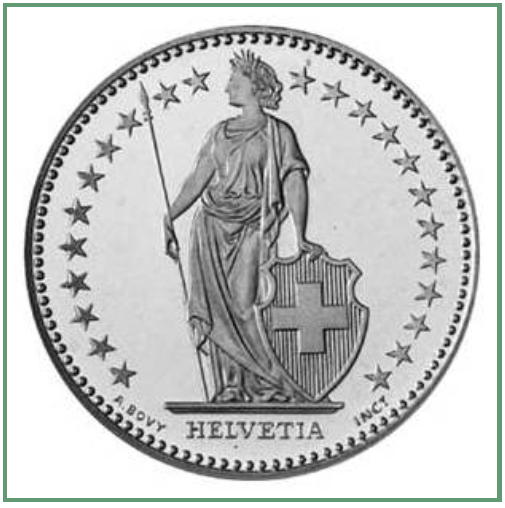
Both the ancient Greeks and the Romans have greatly contributed to formalizing the priority of the group over the subject alone (cf. democracy, senate). Christianity proposes a view in which, in a fundamental way, the group transcends the individual (cf. mystical body).
According to Marx, it is also a collective entity, the class, which should impose its choices on society as a whole (first capital, then the proletariat, with the hope of a “communism” then, expected for the end of History). Compared to Hegel’s dialectic, Marx takes much more into account the real, but he remains a prisoner of very reductive schemas in the imaginary, and projects these schemas into a hypothetical reality still to come, without convincing us.
Let us recall that in the framework of the MCS theory of cognition, even in a group (“left-wing” concept), the individual is sometimes led to assume personally, to decide and act on the basis of his own free will (“right-wing” concept), thus shortening any possible delay considered deleterious, acting either already as an element of this group, or even more decisively as the agent closest to the action.
Above all, today’s heterogeneous and complex world requires a kind of cohabitation: on the political level, secularism confined to the real; and on the religious and ethical level, values that mobilize the imaginary.
6 Bridges between real and imaginary worlds
Two gateways seem to me to be decisive for the real world and the imaginary world not only to coexist (“co-being”) but often even to cooperate! On the one hand, biological resources have been developing for millions of years; and on the other hand, especially in recent decades, human engineering has been progressing.
Biological bridge. For a long time unique, the first bridge between the real and the imaginary is biological in nature. Lamarck was a pioneer in discovering the continent he called biology, which at the time was largely unexplored in its intrinsic terms, particularly in the ability of living organisms to mutate naturally, thus allowing species to evolve by their own means [25- 27 and 9]. While remaining materialistic, i.e., starting exclusively from physico-chemical phenomena, according to the strict schemes of conventional science, Lamarck sought with great success to account for life as well, beyond traditional conceptions.
In humans, the senses ensure the passage from the physical world to the imaginary world. This is obvious in vision, where the eye literally forms an image of reality on the retina. By analogy, the same is true for all sensations, via very varied physical properties conveying information (sound, light, pressure, heat, etc.). In a similar way, the bee orientates itself, and the ant favors the paths marked out by its fellow creatures. And even in plants, the tendril of a vine branch shoots out into space and detects the possible contact of a support. In the other direction, from the imaginary to the real, the most obvious in humans is undoubtedly the muscular control; this is notably how humans move their limbs, or make their phonatory system speak. The bee flies towards the flower or towards its hive. The tendril wraps itself around the detected support and thus clings to it.
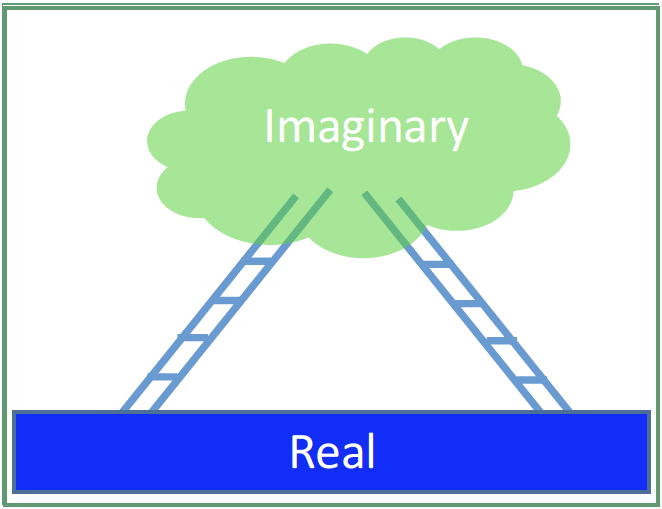
Technology gateway. In principle, humans have, since they exist, developed certain tools capable of translating a real phenomenon into an element of the imagination; they are undoubtedly not the only animate beings who can do so in simple cases. It is for example the case of a tree or a rudimentary bar indicating the time by its shadow. But since the industrial revolution, movement has greatly accelerated and today countless physical phenomena can be measured, with an immense variety of representations, all of them imaginary.
In the other direction, from the imaginary to the real, the passage also takes place with a great wealth of modalities, from the simplest, such as switching traffic lights, Morse code restitution, activating actuators or motors, to the most elaborate, such as voice synthesis, graphic rendering, or 3D printing.
Physics enabled the first transducers, proving the principles, then the industry multiplied the systems. Today, for example, a smartphone routinely captures pressure, electric and magnetic fields, sound, image and motion; and in the other direction, it can talk, make music, generate light, images and graphics, vibrate and emit electromagnetic signals; in the real world.
7 Memory and regularities
The real is in the moment. According to the current model of time, the real is entirely “compressed” in the infinitely thin film of the present, between past and future.
Nevertheless, a certain ambiguity remains in these considerations for a cognitive agent insofar as certain real elements, therefore relating to the present, are so evocative of the past or of a probable future that they seem to escape the present and thus bring a concrete substance to both the past and the future, to these imaginary constructions. Facing the Great Pyramids of Ancient Egypt, can we be convinced today that these ancient pyramids do no longer exist, that we only see and touch their current traces? It is not intuitive, because indeed, the present is able to concretely represent the disappeared reality, relative to other moments of time. This property may prove useful and is thus widely exploited. If words fly away and typically disappear, the Romans already said it: “scripta manent”, the written words remain.
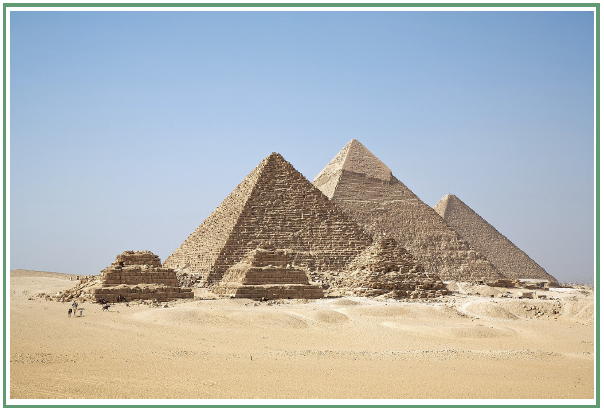
There is permanence in the real world, and it is precisely the role of memory to keep a suitable trace of a past element that we wish to retain over time: writing, monuments, audio recordings, photography, videos, etc. .
The biological world has thus systematized the use of traces with a cognitive, sustainable, reusable, anticipatory vocation. This is notably the case for certain neuronal connections or DNA.
Evidently, certain traces (now, in the real) can indeed evoke a bygone real; in this sense it must be admitted that a certain imaginary is perceptible, and this as much as an ordinary real (let us note that even the latter is finally perceptible only in an infinitesimal way); a form of concretization of the imaginary is thus possible. From then on, the door is open to possible visions of the future, like a hallucination, a mirage, like the rendering of a virtual reality device, or like the preview of a show and astronaut exercises in a swimming pool to prepare a repair in space.
When humans compare and recognize, they seem to proceed by progressive equivalents. A bit like a Roman scale or, better yet, its dynamic equivalent, the Lempel-Ziv-Welch coding algorithm (LZW, [28, and 9]). On the scale, weight estimation is done by compensation, i.e. by searching for equilibrium, first with the heaviest possible standard weight without exceeding the load to be measured, and then, if necessary, by adding possible supplements of smaller weights until equilibrium is reached. In the LZW algorithm, such a more complex configuration, as soon as it is encountered, receives its own code and in turn becomes a new standard for subsequent comparisons. Analogous to these standard weights, Kant starts the cognitive process of perception with the noumenes specific to the agent present in the world. Let us postulate that then, as in the LZW case, the traces collected by the body (memory phenomenon, learning) can be added to the battery of initial noumenes to increase expertise (know-how, skills, quick knowing).
It is thus thanks to the support of memory, and, more generally, to very real traces, always in the moment, that regularities are fixed, thus allowing the cognitive agent infinite escapes to the past, the future and the virtual worlds of the imaginary.
8 Singular case of time. Correspondence between real and imaginary.
The first two “colors” of our MCS theory of cognition, the real-imaginary duality helps to better reconcile the apparently contradictory views of time as often proposed in philosophy.
The main view of time is undoubtedly the one that situates time in the imaginary. It is this view that has been adopted above, already well formulated by Aristotle, notably taken up by Augustine of Hippo, and undoubtedly still almost universally accepted today: the past and the future are not, and the present is only a film of nothingness between the two… (The definition of time in the MCS theory of cognition is undoubtedly more luminous, explaining the notions of permanence and change, and even quantifying these dual properties, but it does not contradict the classical views).
The important corollary to add is that then, of course, none of the laws of reality apply spontaneously in this time, itself of an imaginary nature; this limits in particular the interest of positivist approaches (cf. Auguste Comte) and the pretensions of science; it also weakens, in the wake of Hegel, and notably with Marx, the ultimately arbitrary postulate of dialectic, and of a so-called direction of history.

But if we focus on the real, a very different model is even more obvious: rather than “zero thickness”, the present is maintained without interruption as long as the agent lives. This is everyone’s intuition, expressed here by the voice of a child: “The present lasts for one second but after that it is a new present, so there are several presents, but the next future will be the next present. But at the same time, it is always the present for us! Because we can’t really live in the future, because for us it’s the present! » [29]. In philosophy, Kierkegaard [21 or 1] has focused his attention on this phenomenon, on the instant, which he proposes as a kind of 4th mode of time, “perpendicular” to the traditional imaginary modes, past, present and future. And it is above all Bergson who radically bases his proposals on this idea of the perpetual instant, where vital momentum and freedom manifest themselves. Heidegger likewise focuses on the present and the real. It is often difficult to follow this philosopher because he seems to have wanted to banish the classical view of time, the simple notions of past, present and future, which belong to the imaginary, to concentrate on the real; but these notions resist; he is therefore led to reintroduce connotations of an implicitly temporal nature, incognito, in innumerable new variants that he proposes, which he considers more intimately associated with the real: being 1 (“seiend”, implicitly in the present), being 2 (“Sein”, out of time, like Parmenides’ for example, and therefore rather evoking permanence), Dasein (the existing), presence in the world, the innumerable radicals of words preceded by German prefixes connoting time in differentiated ways, notably in relation to the traditional categories past-present-future: ex-, ge-, ver-, er-, vor-, ent-. Without formulating itself as conventionally as in the current sentence, Heidegger’s existence overlaps the present, with a connotation of change, implying the past that one leaves and the future that begins, evoked in his works for example by the following explicit words, respectively of death and possibilities; sometimes in the traditional sense, going from the past to the future, as existence; and sometimes in the opposite direction, as the past (Gewesenheit) that “is born of the future” [Heidegger in 1, p.418].
Other documents can be downloaded, in French or English, from the web site indicated (www.roboptics.ch/publications-jdd-plus). In particular, there is a document of about thirty pages, focused on the concept of time, in a mainly scientific context, but also integrating philosophical and artistic aspects; click here to download it.
9 Boundaries between real and imaginary
Assuming a schematic approach, necessary for any good modeling, real and imaginary are clearly disjointed. But the temptation is often great to let one category tend towards universality, and if this is done for several categories, in the end they all end up being superimposed and thus merged. For example, Geneva is totally different from Tokyo, as long as they are observed at most on the scale of a continent. Beyond that, on the scale of a planet or a galaxy, they merge completely.
In philosophy, the boundary between the real and the imaginary has often fluctuated.
For Aristotle, if in our time (the millennia in which we live) the situation seems balanced, everything would have started, a long time ago, with matter alone, the pure real, and should end, in the distant future, with the pure act, synonymous with thought and imaginary.
Some have proclaimed the major importance of the real. For Parmenides, the real (being; facts) is. Beyond that, it is the imaginary (the doxa, in his jargon; opinion). Hume attaches himself first and foremost to reality, to the same sense of the real [30 and 9]. Husserl, with his phenomenology, is also emblematic of the view of the world according to which the real is complex, and finally unknowable in an exhaustive way, despite the efforts devoted to perceiving it [31 and 9].
Conversely, Plato and his Ideas, or Hegel and his dialectics are more radically situated in the imaginary.
Without going so far, Kant also ignores the real as such, and starts his reflections from “reality” as he defines it, not directly as the real, but as what is perceived from it beyond the filter of the senses, in resonance with the a priori categories of the cognitive agent [32 and 9], in the imaginary therefore. Similarly, reality shapes up on the basis of observations, for a scientist like Max Planck [33]. A constructivist like Edgar Morin [34-35] adopts an even more balanced position; he thus introduces the term coconstructivism to formally recognize the non-negligible influence of the real in the subject’s creation of his own imaginary reality.
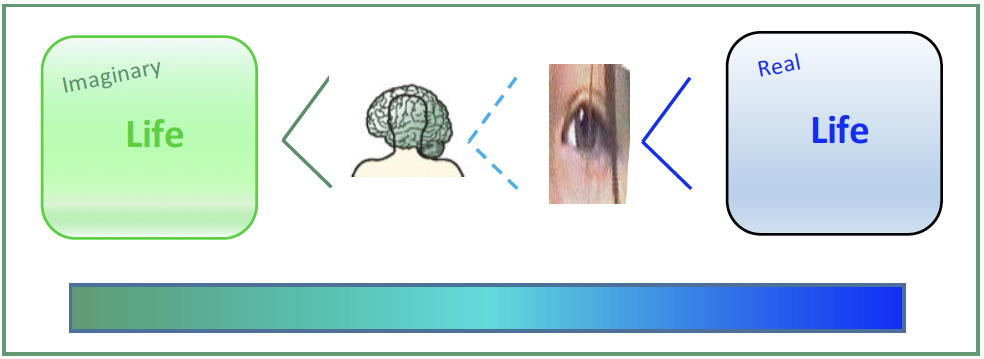
The same arbitrariness about the limit between the real and the imaginary can be conceived at the very local level of a perceived element. In humans, the senses ensure the passage from the physical world to the imaginary world. This is obvious for sight, where in a first phase, the eye already literally forms an image of the real on the retina; then the retina converts the light signal into an electrical signal, which could also justify a boundary between real and imaginary; and so on, via multiple chemical reactions and electrical phenomena, up to the traces concretely shaped as memory elements in the brain. Are we going to take the imaginary back to the retina? Or on the contrary, are we going to consider that everything is real in this journey? As with any model, it depends on the goal in question. For an optician, the image on the retina gains to be considered as real, whereas for a philosopher or a behaviorist, the image formed on the retina gains to be considered as the representation (imaginary therefore) of the real with which the subject is confronted in the moment.
Widening the subject to the level of the living and values, the same arbitrariness in the position of the limit between the real and the imaginary can be encountered. As an example of extreme and opposite positions, the advocate of the real will point out the concrete conditions necessary for living (surviving), while the advocate of the imaginary will be able to quote the Stoic Marcus Aurelius: The happiness of your life depends on the nature of your thoughts [36].
10 Conclusion
In conclusion, the four “color” model of the MCS theory of cognition (real, imaginary, values and collective) offers an interesting prism to reinterpret the propositions of philosophers to date.
In a major way in my path, the deepest prior influence probably comes from Parmenides and especially Aristotle, as well as from Christianity, mainly Catholic. Of course, many elements are added from other sources, of the most diverse, notably philosophical (e.g. more than twenty philosophers are mentioned in this article), but also from Greek democracy, from engineering studies, and then, supporting my most original contributions, from my training (in digital electronics, software and technical computing), as well as from my experience and my research in robotics and automation.
All this has allowed a new, axiomatic and quantitative approach to knowledge, intelligence and cognition in general, considered both intrinsically (including a kind of epistemology taking into account our computerized world) and in relation to real life [2].
At the time of concluding this article, it seems appropriate to attempt an answer to Kant’s three fundamental and famous questions. But rather than linearly, in the traditional order, MCS cognition theory invites to consider these questions in a circular way, starting with the last one, which focuses on values: What may I hope? Alive, active and optimistic therefore, I aim for an improvement of the current situation, through my contributions, in cooperation with others. What can I know? Having already received and acquired a lot of knowledge, relating to the real as well as to the imaginary, personal and collective, I notice nevertheless that this is only infinitesimal compared to the infinite mysteries of these worlds. What must I do? I must live aiming for a certain better day by day, curious about new opportunities, and, in the face of threats, prudent, but also, when human dignity demands it, daring.
References
[1] Jeanne Hersch, L’étonnement philosophique, Une histoire de la philosophie, Editions Gallimard, Folio, Essais, 216, juillet 2003, 462 pp.
[2] Jean-Daniel Dessimoz, «Cognition and Cognitics – Definitions and Metrics for Cognitive Sciences, in Humans, and for Thinking Machines, 2nd edition, augmented, with considerations of life, through the prism “real – imaginary – values – collective”, and some bubbles of wisdom for our time », Jean-Daniel Dessimoz, Roboptics Editions llc, Cheseaux-Noreaz, Switzerland, 346 pp, March 2020. Electronic version: ISBN 978-2-9700629-4-3, printed version: ISBN 978-2-9700629-3-6, https://www.roboptics.ch/editions-english/
[3] Maurice Sachot, « Parménide : enfin une clef ? », Les Cahiers philosophiques de Strasbourg – En ligne, 36 | 2014, mis en ligne le 14 décembre 2018, consulté le 24 juin 2020. URL : http://journals.openedition.org/cps/1275 ; DOI : https://doi.org/10.4000/cps.1275
[4] cf. Charles Appuhn, Œuvres de Spinoza, Paris, Garnier, 1929; Harry Austryn Wolfson, The Philosophy of Spinoza, Cambridge-Mass., Harvard University Press, 1934; ou [1].
[5] Descartes, René, Discours de la méthode (1637), quatrième partie
[6] Martin Heidegger, Sein und Zeit, Essai philosophique, Éditeur Max Niemeyer, Halle, Allemagne, 1927.
[7] Georg Wilhelm Friedrich Hegel, La Science de la logique, La Théorie de l’être. Par ex. via Jean-Marie Lardic, Hegel : Leçons Sur la Logique (1831), Biblio Textes Philosophiques, Librairie Philosophique Vrin, Lundi 12 Février 2007, 203 pages, ISBN-10 : 2711618536.
[8] R. Taton, Histoire générale des sciences, t. I, Paris, Presses Universitaires de France, 1957, p. 217 ; et [9]
[9] Wikipedia, encyclopédie en ligne, yc archives occasionnelles, pour chemin indirect ayant permis d’accèder à des références plus directes, citées par ailleurs.
[10] Lev Landau et Evguéni Lifchitz, « Physique théorique », vol. 1. Mécanique, trad. Claude Ligny, Éditions Mir, Moscou, ISBN 5-03-000198-0, 1982
[11] Platon : Oeuvres complètes — Les 43 titres (Annotés) – Platon – Google Livres, consulté 11 Jan. 2020, https://books.google.ch/books/about/Platon_Oeuvres_complètes_Les_43_titres.html?hl=fr&id=ZIo0JhQW13cC&redir_esc=y
[12] Pierre Pellegrin (dir.), Aristote : Œuvres complètes, Éditions Flammarion, 2014, 2923 p. (ISBN 978-2081273160).
[13] École de Milet – Encyclopædia Universalis, accès le 16 juillet 2020
[14] Héraclite – Fragments (trad. Marcel Conche), PUF, coll. Épiméthée, Paris, 1986 (4e éd. 1998), 2005 (2e tirage), (ISBN 2130440037).
[15] Karl Marx, Œuvres, 4 tomes parus (Économie 1, Économie 2, Philosophie, Politique 1), Bibliothèque de la Pléiade, édition dirigée par Maximilien Rubel.
[16] Bergson, Henri, L’Évolution créatrice , Éditeur Félix Alcan, Paris, France, 1907
[17] « Nietzsche et le surhomme », Les Grands Philosophes, Site La-Philo, pp.8 , consulté le 29 juillet 2020
[18] Augustin d’Hippone, Œuvres philosophiques complètes, traduction Poujoulat, Raulx, Labriolle, éd. Les Belles Lettres, coll. Classiques favoris, 2018, 3312 p.
[19] Sartre, Jean-Paul, L’Etre et le Néant, Gallimard, 1943, et https://www.les-philosophes.fr/penseurs/letre-et-le-neant/Page-6.html Accès le 30 juillet 2030
[20] Auguste Comte, Le Cours de philosophie positive (1830-1842) ; et site La-Philo, Science et philosophie de l’Humanité, positivisme, Auguste Comte, Accès le 30 juillet 2030
[21] Baron, Christine, « Kierkegaard inconnu : récit contre concept », in « Les Philosophes lecteurs », Fabula-LhT, n° 1, février 2006, https://www.fabula.org/lht/1/Baron.html ; Accès le 30 juillet 2020.
[22] Jeanne Hersch, Karl Jaspers, Paris, L’Âge d’homme, 2002 (1re éd. 1978), 165 p. (ISBN 2-8251-1727-7)
[23] Russell, Bertrand, « Essais sceptiques », André Bernard (Traducteur), Le goût des idées , Editeur: Belles Lettres, 262 pages, 2011 ;
[24] Dunbar, Robin, “The Social Brain Hypothesis”, Evolutionary Anthropology, Wiley-Liss, Inc., 1998, pp178-190
[25] Lamarck, Jean-Baptiste de, « Philosophie zoologique », Paris, Flammarion, 1994 [1809], pp. 109–110.
[26] Corsi, Pietro. « Lamarck. Genèse et enjeux du transformisme. 1770–1830 », CNRS Éditions, 434 p. 2001, ISBN 2-271-05701-9.
[27] Antzoulatos, Vangelis, « La force vitale : un vieux concept aux multiples facettes », site web Le Cortecs, Accès le 11 juillet 2020
[28] Lempel-Ziv-Welch, Comparatif des performances de différentes méthodes de compression de fichiers (http://rlwpx.free.fr/WPFF/comploc.htm); accès 020.08.02 .
[29] « Et Maintenant – Spectacles dans la rue», Programme, yc.Rendez-vous A, TAC TIC TIC TAC, Conception Wanda Smith, Wanda Smith et Wanda Smith, Lausanne, 3-5 juillet 2020.
[30] Hume, David, « Traité de la nature humaine », 1739-1740, accès sur david-hume.fr (archives wiki) 2 août 2020
[31] Husserl, Edmund, Méditations cartésiennes, Sorbonne, Paris, 23 et 25 février 1929, trad. Emmanuel Levinas 1931
[32] Kant, Emmanuel, « Critique de la raison pure », trad. Tremesaygues et Pacaud, PUF, coll. « Bibliothèque de Philosophie contemporaine », 1975, 8e éd., 584 p..
[33] Planck, Max, L’image du monde dans la physique contemporaine (Éd. Gonthier, 1933).
[34] Morin, Edgar, « La Méthode », 6 vols, Paris, Le Seuil, 1977-2004
[35] Citation Edgar Morin , dans l’article Réalité de [9], https://fr.wikipedia.org/wiki/Réalité ; accès le 27 juillet 2020
[36] Bernard Guévorts, Site Les chemins de la sagesse, Marc Aurèle, Pensées, livre 8, XXII ; Accès 2 août 2020
[F1] MCS, as the initials of Model for Cognitive Sciences.
[F2] Adopting the style of Hegel’s system, one could, for example, formulate the time defined in MCS theory of cognition, both in the broad and strict sense, as follows: 1. Thesis. Reality is permanent. 2. Antithesis. Permanence is not, it is change that applies. 3. Synthesis. Between these two extremes, time (in the general sense) can be sketched out: reality evolves, and time (in the strict sense, evaluated in seconds) measures permanence, while its inverse, speed, contributes to measure change.
Particular reference:
Jean-Daniel Dessimoz, « Cognition and Cognitics – Definitions and Metrics for Cognitive Sciences, in Humans, and for Thinking Machines, 2nd edition, augmented, with considerations of life, through the prism “real – imaginary – values – collective”, and some bubbles of wisdom for our time », Roboptics Editions llc, Cheseaux-Noreaz, Switzerland, 345 pp, March 2020.
Work in progress ! This site is still under construction. For additional contents, please refer to our classical websites still in use : cognitics.org, cognitics.populus.org